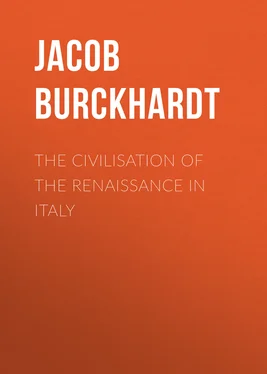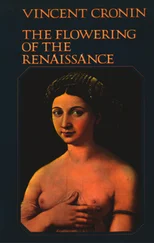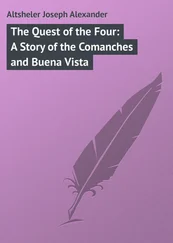Jacob Burckhardt - The Civilisation of the Renaissance in Italy
Здесь есть возможность читать онлайн «Jacob Burckhardt - The Civilisation of the Renaissance in Italy» — ознакомительный отрывок электронной книги совершенно бесплатно, а после прочтения отрывка купить полную версию. В некоторых случаях можно слушать аудио, скачать через торрент в формате fb2 и присутствует краткое содержание. Жанр: foreign_prose, История, foreign_edu, foreign_antique, на английском языке. Описание произведения, (предисловие) а так же отзывы посетителей доступны на портале библиотеки ЛибКат.
- Название:The Civilisation of the Renaissance in Italy
- Автор:
- Жанр:
- Год:неизвестен
- ISBN:нет данных
- Рейтинг книги:5 / 5. Голосов: 1
-
Избранное:Добавить в избранное
- Отзывы:
-
Ваша оценка:
- 100
- 1
- 2
- 3
- 4
- 5
The Civilisation of the Renaissance in Italy: краткое содержание, описание и аннотация
Предлагаем к чтению аннотацию, описание, краткое содержание или предисловие (зависит от того, что написал сам автор книги «The Civilisation of the Renaissance in Italy»). Если вы не нашли необходимую информацию о книге — напишите в комментариях, мы постараемся отыскать её.
The Civilisation of the Renaissance in Italy — читать онлайн ознакомительный отрывок
Ниже представлен текст книги, разбитый по страницам. Система сохранения места последней прочитанной страницы, позволяет с удобством читать онлайн бесплатно книгу «The Civilisation of the Renaissance in Italy», без необходимости каждый раз заново искать на чём Вы остановились. Поставьте закладку, и сможете в любой момент перейти на страницу, на которой закончили чтение.
Интервал:
Закладка:
The famous Greek, Cardinal Bessarion, 440in whom patriotism was mingled with a zeal for letters, collected, at a great sacrifice (30,000 gold florins), 600 manuscripts of pagan and Christian authors. He then looked round for some receptacle where they could safely lie until his unhappy country, if she ever regained her freedom, could reclaim her lost literature. The Venetian government declared itself ready to erect a suitable building, and to this day the library of St. Mark retains a part of these treasures. 441
The formation of the celebrated Medicean library has a history of its own, into which we cannot here enter. The chief collector for Lorenzo Magnifico was Johannes Lascaris. It is well known that the collection, after the plundering in the year 1494, had to be recovered piecemeal by the Cardinal Giovanni Medici, afterwards Leo X.
The library of Urbino, 442now in the Vatican, was wholly the work of the great Frederick of Montefeltro ( p. 44sqq.). As a boy he had begun to collect; in after years he kept thirty or forty ‘scrittori’ employed in various places, and spent in the course of time no less than 30,000 ducats on the collection. It was systematically extended and completed, chiefly by the help of Vespasiano, and his account of it forms an ideal picture of a library of the Renaissance. At Urbino there were catalogues of the libraries of the Vatican, of St. Mark at Florence, of the Visconti at Pavia, and even of the library at Oxford. It was noted with pride that in richness and completeness none could rival Urbino. Theology and the Middle Ages were perhaps most fully represented. There was a complete Thomas Aquinas, a complete Albertus Magnus, a complete Buenaventura. The collection, however, was a many-sided one, and included every work on medicine which was then to be had. Among the ‘moderns’ the great writers of the fourteenth century—Dante and Boccaccio, with their complete works—occupied the first place. Then followed twenty-five select humanists, invariably with both their Latin and Italian writings and with all their translations. Among the Greek manuscripts the Fathers of the Church far outnumbered the rest; yet in the list of the classics we find all the works of Sophocles, all of Pindar, and all of Menander. The last must have quickly disappeared from Urbino, 443else the philologists would have soon edited it. There were men, however, in this book-collecting age who raised a warning voice against the vagaries of the passion. These were not the enemies of learning, but its friends, who feared that harm would come from a pursuit which had become a mania. Petrarch himself protested against the fashionable folly of a useless heaping up of books; and in the same century Giovanni Manzini ridiculed Andreolo de Ochis, a septuagenarian from Brescia, who was ready to sacrifice house and land, his wife and himself, to add to the stores of his library.
We have, further, a good deal of information as to the way in which manuscripts and libraries were multiplied. 444The purchase of an ancient manuscript, which contained a rare, or the only complete, or the only existing text of an old writer, was naturally a lucky accident of which we need take no further account. Among the professional copyists those who understood Greek took the highest place, and it was they especially who bore the honourable name of ‘scrittori.’ Their number was always limited, and the pay they received very large. 445The rest, simply called ‘copisti,’ were partly mere clerks who made their living by such work, partly schoolmasters and needy men of learning, who desired an addition to their income, partly monks, or even nuns, who regarded the pursuit as a work pleasing to God. In the early stages of the Renaissance the professional copyists were few and untrustworthy; their ignorant and dilatory ways were bitterly complained of by Petrarch. In the fifteenth century they were more numerous, and brought more knowledge to their calling, but in accuracy of work they never attained the conscientious precision of the old monks. They seem to have done their work in a sulky and perfunctory fashion, seldom putting their signatures at the foot of the codices, and showed no traces of that cheerful humour, or of that proud consciousness of a beneficent activity, which often surprises us in the French and German manuscripts of the same period. This is more curious, as the copyists at Rome in the time of Nicholas V. were mostly Germans or Frenchmen 446—‘barbarians’ as the Italian humanists called them, probably men who were in search of favours at the papal court, and who kept themselves alive meanwhile by this means. When Cosimo de’ Medici was in a hurry to form a library for his favourite foundation, the Badia below Fiesole, he sent for Vespasiano, and received from him the advice to give up all thoughts of purchasing books, since those which were worth getting could not be had easily, but rather to make use of the copyists; whereupon Cosimo bargained to pay him so much a day, and Vespasiano, with forty-five writers under him, delivered 200 volumes in twenty-two months. 447
Конец ознакомительного фрагмента.
Текст предоставлен ООО «ЛитРес».
Прочитайте эту книгу целиком, на ЛитРес.
Безопасно оплатить книгу можно банковской картой Visa, MasterCard, Maestro, со счета мобильного телефона, с платежного терминала, в салоне МТС или Связной, через PayPal, WebMoney, Яндекс.Деньги, QIWI Кошелек, бонусными картами или другим удобным Вам способом.
1
History of Architecture , by Franz Kugler. (The first half of the fourth volume, containing the ‘Architecture and Decoration of the Italian Renaissance,’ is by the Author.)
2
Macchiavelli, Discorsi , 1. i. c. 12. ‘E la cagione, che la Italia non sia in quel medesimo termine, ne habbia anch’ ella ò una republica ò un prencipe che la governi, è solamente la Chiesa; perchè havendovi habitato e tenuto imperio temporale non è stata si potente ne di tal virtè, che l’habbia potuto occupare il restante d’Italia e farsene prencipe.’
3
The rulers and their dependents were together called ‘lo stato,’ and this name afterwards acquired the meaning of the collective existence of a territory.
4
C. Winckelmann, De Regni Siculi Administratione qualis fuerit regnante Friderico II. , Berlin. 1859. A. del Vecchio, La legislazione di Federico II. imperatore . Turin, 1874. Frederick II. has been fully and thoroughly discussed by Winckelmann and Schirrmacher.
5
Baumann, Staatslehre des Thomas von Aquino . Leipzig, 1873, esp. pp. 136 sqq.
6
Cento Novelle Antiche , ed. 1525. For Frederick, Nov. 2, 21, 22, 23, 24, 30, 53, 59, 90, 100; for Ezzelino, Nov. 31, and esp. 84.
7
Scardeonius, De Urbis Patav. Antiqu. in Grævius , Thesaurus, vi. iii. p. 259.
8
Sismondi, Hist. de Rép. Italiennes , iv. p. 420; viii. pp. 1 sqq.
9
Franco Sacchetti, Novelle (61, 62).
10
Dante, it is true, is said to have lost the favour of this prince, which impostors knew how to keep. See the important account in Petrarch, De Rerum Memorandarum , lib. ii. 3, 46.
Читать дальшеИнтервал:
Закладка:
Похожие книги на «The Civilisation of the Renaissance in Italy»
Представляем Вашему вниманию похожие книги на «The Civilisation of the Renaissance in Italy» списком для выбора. Мы отобрали схожую по названию и смыслу литературу в надежде предоставить читателям больше вариантов отыскать новые, интересные, ещё непрочитанные произведения.
Обсуждение, отзывы о книге «The Civilisation of the Renaissance in Italy» и просто собственные мнения читателей. Оставьте ваши комментарии, напишите, что Вы думаете о произведении, его смысле или главных героях. Укажите что конкретно понравилось, а что нет, и почему Вы так считаете.












